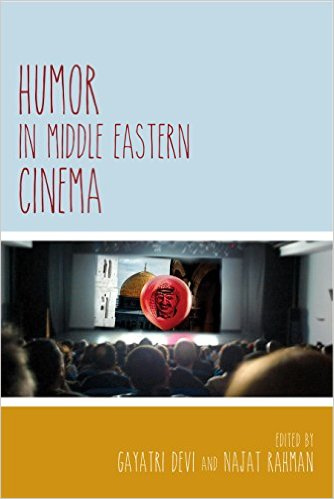By Lynne Rogers
Humor in Middle Eastern Cinema
Edited by Gayatri Devi and Najat Rahman
Wayne State University Press, 2014
Editors Gayatri Devi and Najat Rahman have collected nine scholarly essays that examine the spaces for change created through comedy and the camera in “Humor in Middle Eastern Cinema.” The contributors, all academics, confront today’s socio-political issues in their interrogations of humor, a cultural dimension unfortunately often overlooked by critics. Devi and Rahman's introduction gives the reader a quick overview of region’s geopolitics, followed by a more thorough introduction to “the modalities of humor.” The first essay, by editor Rahman, uses Ranciere’s paradigm of “political subjectivation” to look at three contemporary Palestinian films made under Israeli Occupation. The laughter provoked by these popular works reaffirms Palestinian identity while providing a release to the constant assault of Occupation, as well as an “alternative vision.” In his essay “Strategies of Subversion in Ben Ali’s Tunisia, Allegory and Satire in Moncef Dhouib’s The TV is Coming” Robert Lang discusses the film’s exploration of “how national-cultural history is written and about how Tunisia is confronting certain political, economic and cultural challenges in the global era” in its “unambiguous” indictment of the Ben Ali regime.
The collection includes one essay on Iranian television and two on Iranian films. Cyrus Ali Zagar views the thunderous resonance with Iranian viewers of the popular television series of Mehran Modiri and his “creation of spaces that explore identity as geographical allegories.” Somy Kim’s “Comedic Mediations, War and Genre in The Outcasts” delineates the film’s contrast between the “thug life and a pious existence.” Released in 2007 and directed by a former Hezbollah General Dehnamaki, this film follows three marginalized young men as they make their way to the 1980’s conflict with Iraq and are transformed into either martyrs or respected war veterans. Kim addresses the criticism of the film by contextualizing the comedy within the Iranian melodramatic martyr narrative, and concludes that “the comedy and its attendant social critique are what appealed to an Iranian audience struggling to accept the strictures of an increasingly restrictive government.” In “Humor and the Cinematic Sublime in Kiarostami’s The Wind Will Carry Us,” editor Devi holds the Iranian filmmaker up to the challenges of Longinus and Kant, arguing“ that the sublime poses one of the most effective humorous challenges to reality’ status quo.” Her treatment of Kiarostami’s work stands as a tribute to the artistry of his films, while her essay exemplifies how the canons of literary theory can be used to deepen our appreciation of contemporary culture. Elise Burton illustrates the use of ethnic humor in Israeli cinema to dismantle “Ashkenazi cultural dominance” and promote cultural equality through laughter.
The collection would not be complete without an essay on the beloved Egyptian filmmaker Youssef Chahine, and Rahman’s essay examines three of Chahine’s films. She maps where the humor meets history, with the harsh urban environment of Cairo in the films providing not only social critique but also inspiring triumphant joy and empathy. Perin Gurel’s essay “traces the development of America and Americans as instruments of comedy in Turkish film from the 1970’s…” and the cultural ambiguities of Hollywood’s influence on Turkish cinema.
In one of the strongest and most controversial essays, “Laughter Across Borders, the Case of the Bollywood Film, Tere Bin Laden,” Mara Matta demonstrates how the comedy of “Tere Bin Laden” reveals the post 9/11 Islamophobic collapse of the “Middle East,” to now include Pakistan. Banned in Pakistan, the film’s carnival spirit crosses geopolitical boundaries, parodying ISIS as well as the global war on terror. Film students will benefit from the academic rigor and thoroughness of these informed essays. Film buffs will enjoy the validation of comedy as a vital social critique and the exposure to films which might have escaped their notice before reading “Humor in Middle Eastern Cinema.”
This article appeared in Al Jadid Magazine, Vol. 19, No. 68, 2015.
Copyright © 2015 AL JADID MAGAZINE

